Disabilities: Behavioral Support, Models, and Ethical Concerns
VerifiedAdded on 2023/06/10
|6
|1231
|331
Homework Assignment
AI Summary
This assignment delves into the multifaceted aspects of living with disabilities, emphasizing the importance of positive behavioral support in enhancing the quality of life for individuals with disabilities. It contrasts the medical and social models of disability, highlighting how societal factors contribute to the experience of disability. The assignment addresses the unmet needs and compromised dignity often faced by disabled individuals. Furthermore, it explores the role of motivation, stress management, meaningful activities, and supportive relationships in fostering a positive lifestyle. It underscores the significance of meeting nutritional needs and the application of positive reinforcement techniques. The discussion extends to crisis management, restrictive practices, and the critical re-evaluation of these practices to ensure ethical and effective care. The paper also highlights the relationship between quality of life and environment, and legal and ethical considerations in disability support. This assignment provides a comprehensive overview, and similar solved assignments can be found on Desklib.
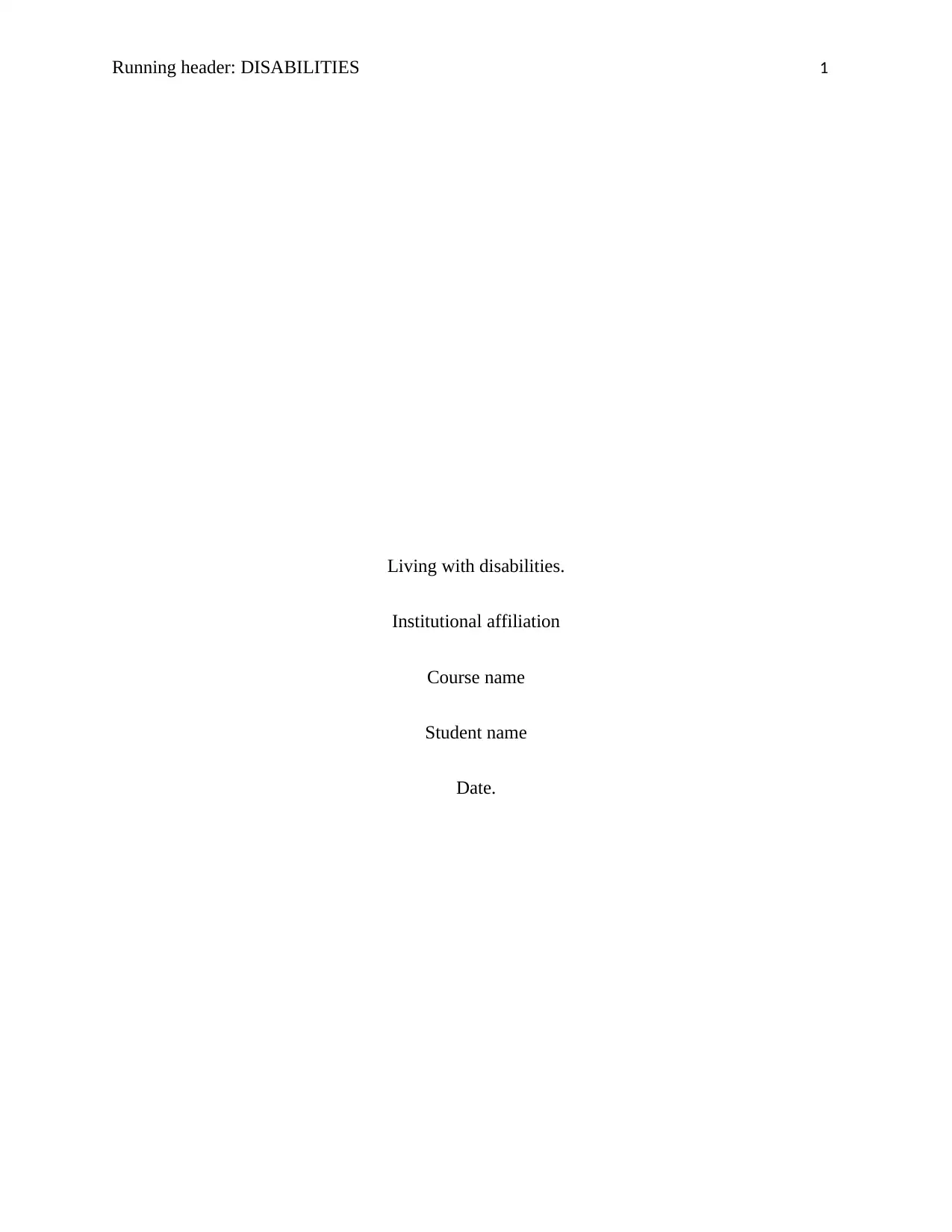
Running header: DISABILITIES 1
Living with disabilities.
Institutional affiliation
Course name
Student name
Date.
Living with disabilities.
Institutional affiliation
Course name
Student name
Date.
Paraphrase This Document
Need a fresh take? Get an instant paraphrase of this document with our AI Paraphraser
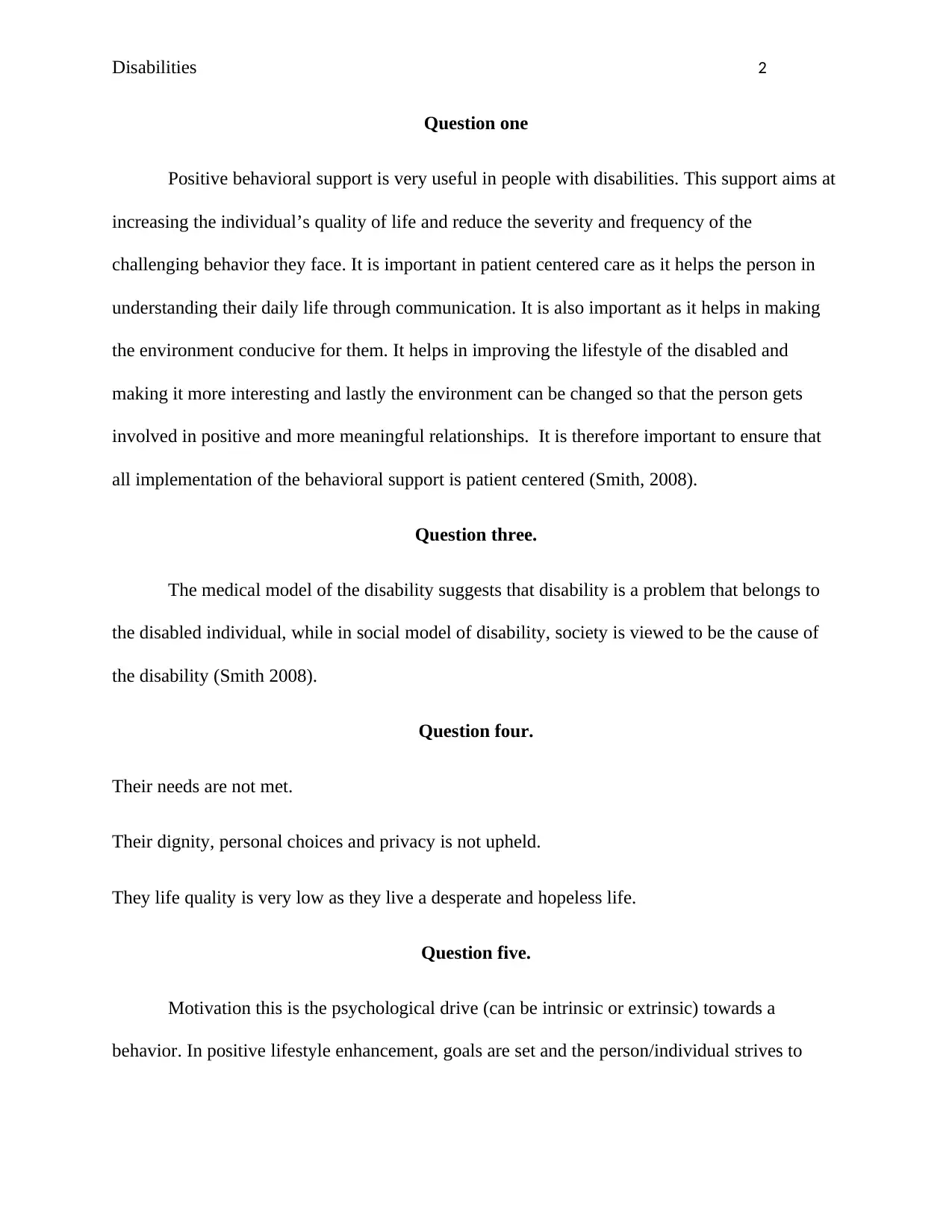
Disabilities 2
Question one
Positive behavioral support is very useful in people with disabilities. This support aims at
increasing the individual’s quality of life and reduce the severity and frequency of the
challenging behavior they face. It is important in patient centered care as it helps the person in
understanding their daily life through communication. It is also important as it helps in making
the environment conducive for them. It helps in improving the lifestyle of the disabled and
making it more interesting and lastly the environment can be changed so that the person gets
involved in positive and more meaningful relationships. It is therefore important to ensure that
all implementation of the behavioral support is patient centered (Smith, 2008).
Question three.
The medical model of the disability suggests that disability is a problem that belongs to
the disabled individual, while in social model of disability, society is viewed to be the cause of
the disability (Smith 2008).
Question four.
Their needs are not met.
Their dignity, personal choices and privacy is not upheld.
They life quality is very low as they live a desperate and hopeless life.
Question five.
Motivation this is the psychological drive (can be intrinsic or extrinsic) towards a
behavior. In positive lifestyle enhancement, goals are set and the person/individual strives to
Question one
Positive behavioral support is very useful in people with disabilities. This support aims at
increasing the individual’s quality of life and reduce the severity and frequency of the
challenging behavior they face. It is important in patient centered care as it helps the person in
understanding their daily life through communication. It is also important as it helps in making
the environment conducive for them. It helps in improving the lifestyle of the disabled and
making it more interesting and lastly the environment can be changed so that the person gets
involved in positive and more meaningful relationships. It is therefore important to ensure that
all implementation of the behavioral support is patient centered (Smith, 2008).
Question three.
The medical model of the disability suggests that disability is a problem that belongs to
the disabled individual, while in social model of disability, society is viewed to be the cause of
the disability (Smith 2008).
Question four.
Their needs are not met.
Their dignity, personal choices and privacy is not upheld.
They life quality is very low as they live a desperate and hopeless life.
Question five.
Motivation this is the psychological drive (can be intrinsic or extrinsic) towards a
behavior. In positive lifestyle enhancement, goals are set and the person/individual strives to
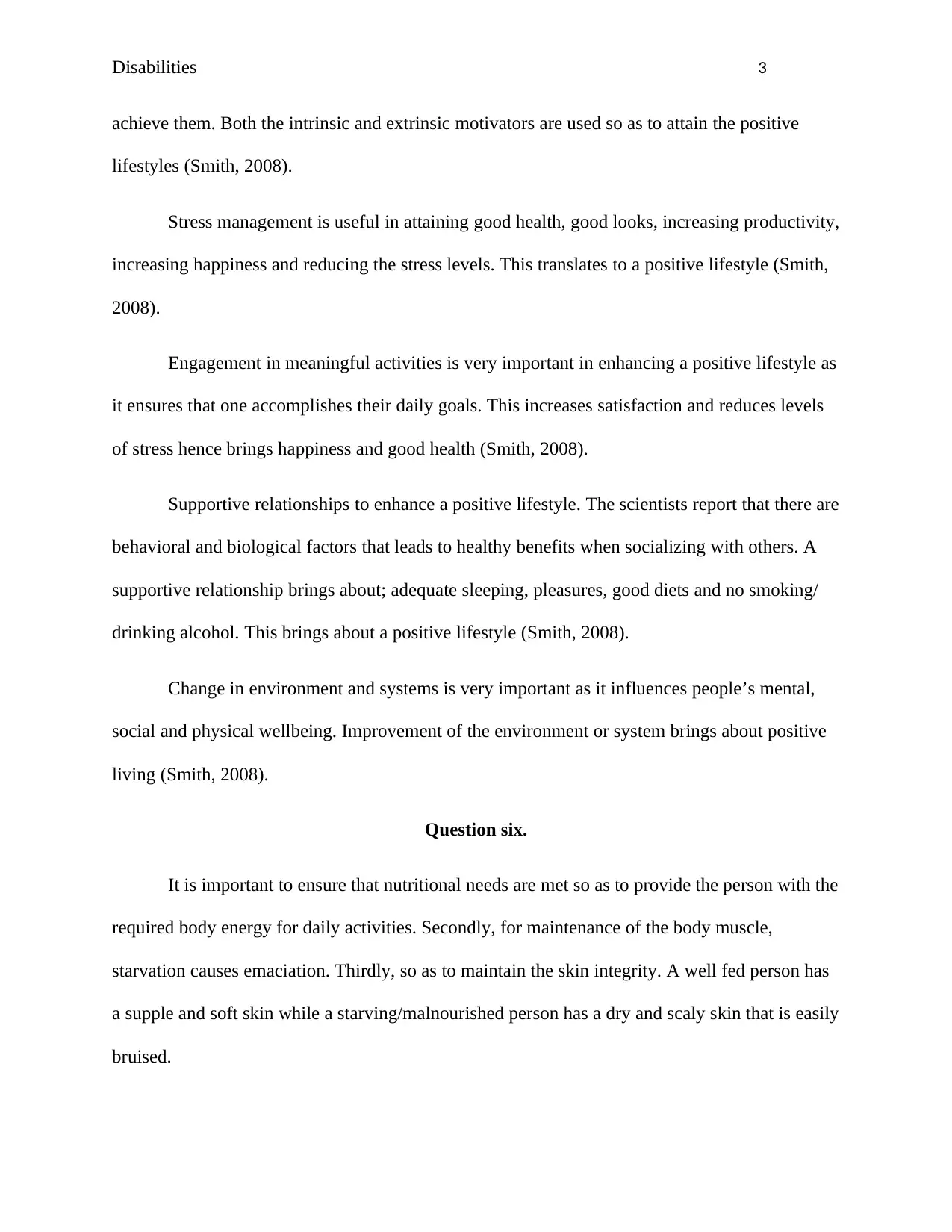
Disabilities 3
achieve them. Both the intrinsic and extrinsic motivators are used so as to attain the positive
lifestyles (Smith, 2008).
Stress management is useful in attaining good health, good looks, increasing productivity,
increasing happiness and reducing the stress levels. This translates to a positive lifestyle (Smith,
2008).
Engagement in meaningful activities is very important in enhancing a positive lifestyle as
it ensures that one accomplishes their daily goals. This increases satisfaction and reduces levels
of stress hence brings happiness and good health (Smith, 2008).
Supportive relationships to enhance a positive lifestyle. The scientists report that there are
behavioral and biological factors that leads to healthy benefits when socializing with others. A
supportive relationship brings about; adequate sleeping, pleasures, good diets and no smoking/
drinking alcohol. This brings about a positive lifestyle (Smith, 2008).
Change in environment and systems is very important as it influences people’s mental,
social and physical wellbeing. Improvement of the environment or system brings about positive
living (Smith, 2008).
Question six.
It is important to ensure that nutritional needs are met so as to provide the person with the
required body energy for daily activities. Secondly, for maintenance of the body muscle,
starvation causes emaciation. Thirdly, so as to maintain the skin integrity. A well fed person has
a supple and soft skin while a starving/malnourished person has a dry and scaly skin that is easily
bruised.
achieve them. Both the intrinsic and extrinsic motivators are used so as to attain the positive
lifestyles (Smith, 2008).
Stress management is useful in attaining good health, good looks, increasing productivity,
increasing happiness and reducing the stress levels. This translates to a positive lifestyle (Smith,
2008).
Engagement in meaningful activities is very important in enhancing a positive lifestyle as
it ensures that one accomplishes their daily goals. This increases satisfaction and reduces levels
of stress hence brings happiness and good health (Smith, 2008).
Supportive relationships to enhance a positive lifestyle. The scientists report that there are
behavioral and biological factors that leads to healthy benefits when socializing with others. A
supportive relationship brings about; adequate sleeping, pleasures, good diets and no smoking/
drinking alcohol. This brings about a positive lifestyle (Smith, 2008).
Change in environment and systems is very important as it influences people’s mental,
social and physical wellbeing. Improvement of the environment or system brings about positive
living (Smith, 2008).
Question six.
It is important to ensure that nutritional needs are met so as to provide the person with the
required body energy for daily activities. Secondly, for maintenance of the body muscle,
starvation causes emaciation. Thirdly, so as to maintain the skin integrity. A well fed person has
a supple and soft skin while a starving/malnourished person has a dry and scaly skin that is easily
bruised.
⊘ This is a preview!⊘
Do you want full access?
Subscribe today to unlock all pages.

Trusted by 1+ million students worldwide
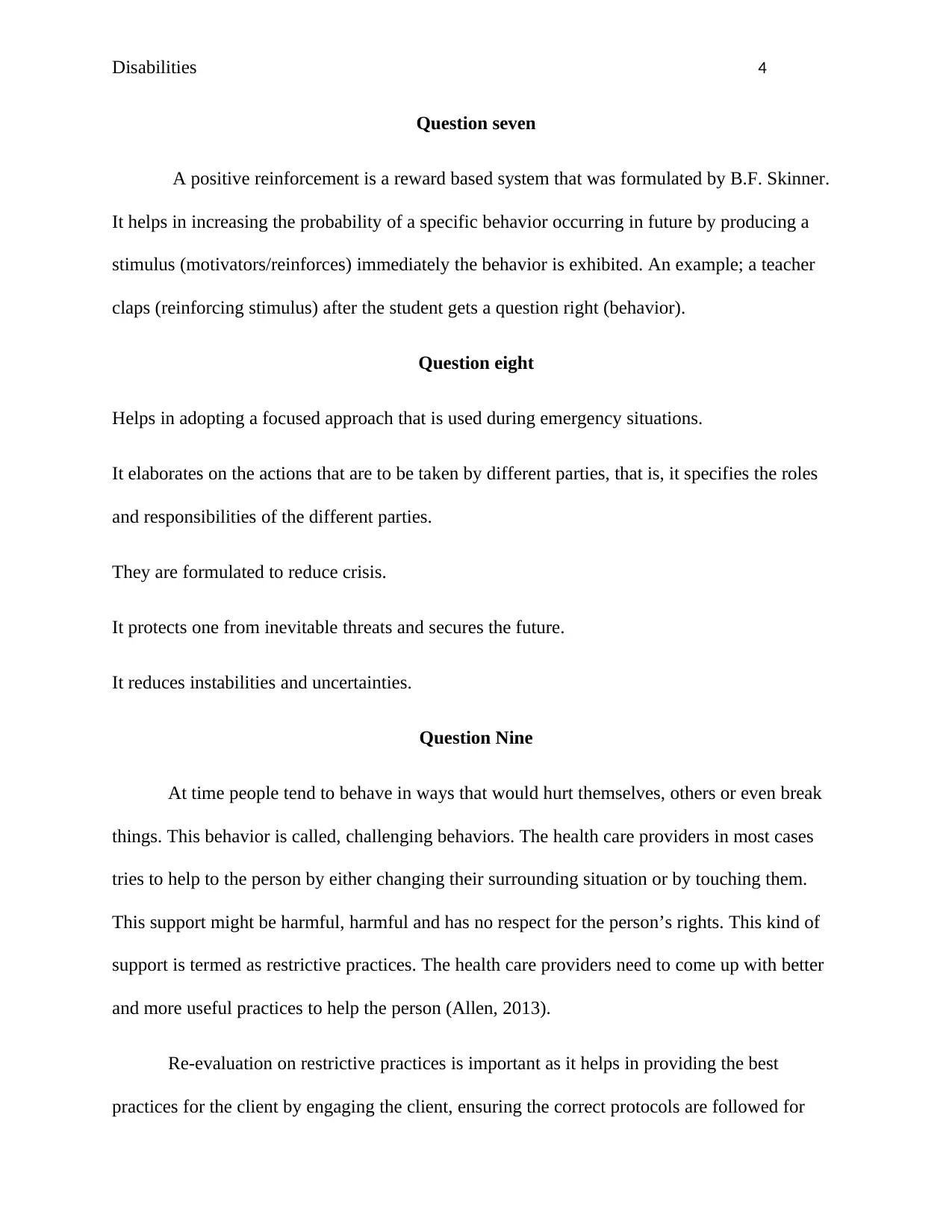
Disabilities 4
Question seven
A positive reinforcement is a reward based system that was formulated by B.F. Skinner.
It helps in increasing the probability of a specific behavior occurring in future by producing a
stimulus (motivators/reinforces) immediately the behavior is exhibited. An example; a teacher
claps (reinforcing stimulus) after the student gets a question right (behavior).
Question eight
Helps in adopting a focused approach that is used during emergency situations.
It elaborates on the actions that are to be taken by different parties, that is, it specifies the roles
and responsibilities of the different parties.
They are formulated to reduce crisis.
It protects one from inevitable threats and secures the future.
It reduces instabilities and uncertainties.
Question Nine
At time people tend to behave in ways that would hurt themselves, others or even break
things. This behavior is called, challenging behaviors. The health care providers in most cases
tries to help to the person by either changing their surrounding situation or by touching them.
This support might be harmful, harmful and has no respect for the person’s rights. This kind of
support is termed as restrictive practices. The health care providers need to come up with better
and more useful practices to help the person (Allen, 2013).
Re-evaluation on restrictive practices is important as it helps in providing the best
practices for the client by engaging the client, ensuring the correct protocols are followed for
Question seven
A positive reinforcement is a reward based system that was formulated by B.F. Skinner.
It helps in increasing the probability of a specific behavior occurring in future by producing a
stimulus (motivators/reinforces) immediately the behavior is exhibited. An example; a teacher
claps (reinforcing stimulus) after the student gets a question right (behavior).
Question eight
Helps in adopting a focused approach that is used during emergency situations.
It elaborates on the actions that are to be taken by different parties, that is, it specifies the roles
and responsibilities of the different parties.
They are formulated to reduce crisis.
It protects one from inevitable threats and secures the future.
It reduces instabilities and uncertainties.
Question Nine
At time people tend to behave in ways that would hurt themselves, others or even break
things. This behavior is called, challenging behaviors. The health care providers in most cases
tries to help to the person by either changing their surrounding situation or by touching them.
This support might be harmful, harmful and has no respect for the person’s rights. This kind of
support is termed as restrictive practices. The health care providers need to come up with better
and more useful practices to help the person (Allen, 2013).
Re-evaluation on restrictive practices is important as it helps in providing the best
practices for the client by engaging the client, ensuring the correct protocols are followed for
Paraphrase This Document
Need a fresh take? Get an instant paraphrase of this document with our AI Paraphraser
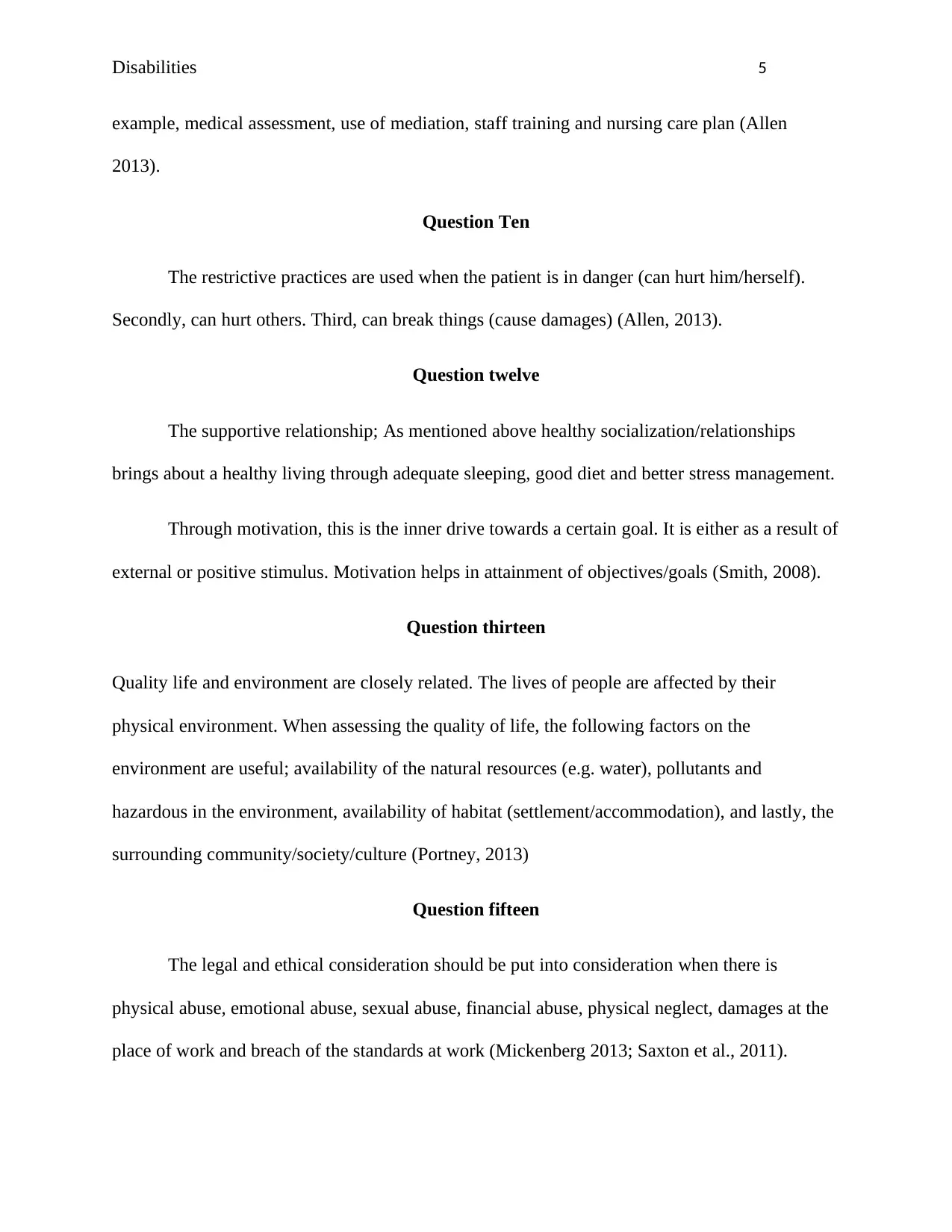
Disabilities 5
example, medical assessment, use of mediation, staff training and nursing care plan (Allen
2013).
Question Ten
The restrictive practices are used when the patient is in danger (can hurt him/herself).
Secondly, can hurt others. Third, can break things (cause damages) (Allen, 2013).
Question twelve
The supportive relationship; As mentioned above healthy socialization/relationships
brings about a healthy living through adequate sleeping, good diet and better stress management.
Through motivation, this is the inner drive towards a certain goal. It is either as a result of
external or positive stimulus. Motivation helps in attainment of objectives/goals (Smith, 2008).
Question thirteen
Quality life and environment are closely related. The lives of people are affected by their
physical environment. When assessing the quality of life, the following factors on the
environment are useful; availability of the natural resources (e.g. water), pollutants and
hazardous in the environment, availability of habitat (settlement/accommodation), and lastly, the
surrounding community/society/culture (Portney, 2013)
Question fifteen
The legal and ethical consideration should be put into consideration when there is
physical abuse, emotional abuse, sexual abuse, financial abuse, physical neglect, damages at the
place of work and breach of the standards at work (Mickenberg 2013; Saxton et al., 2011).
example, medical assessment, use of mediation, staff training and nursing care plan (Allen
2013).
Question Ten
The restrictive practices are used when the patient is in danger (can hurt him/herself).
Secondly, can hurt others. Third, can break things (cause damages) (Allen, 2013).
Question twelve
The supportive relationship; As mentioned above healthy socialization/relationships
brings about a healthy living through adequate sleeping, good diet and better stress management.
Through motivation, this is the inner drive towards a certain goal. It is either as a result of
external or positive stimulus. Motivation helps in attainment of objectives/goals (Smith, 2008).
Question thirteen
Quality life and environment are closely related. The lives of people are affected by their
physical environment. When assessing the quality of life, the following factors on the
environment are useful; availability of the natural resources (e.g. water), pollutants and
hazardous in the environment, availability of habitat (settlement/accommodation), and lastly, the
surrounding community/society/culture (Portney, 2013)
Question fifteen
The legal and ethical consideration should be put into consideration when there is
physical abuse, emotional abuse, sexual abuse, financial abuse, physical neglect, damages at the
place of work and breach of the standards at work (Mickenberg 2013; Saxton et al., 2011).
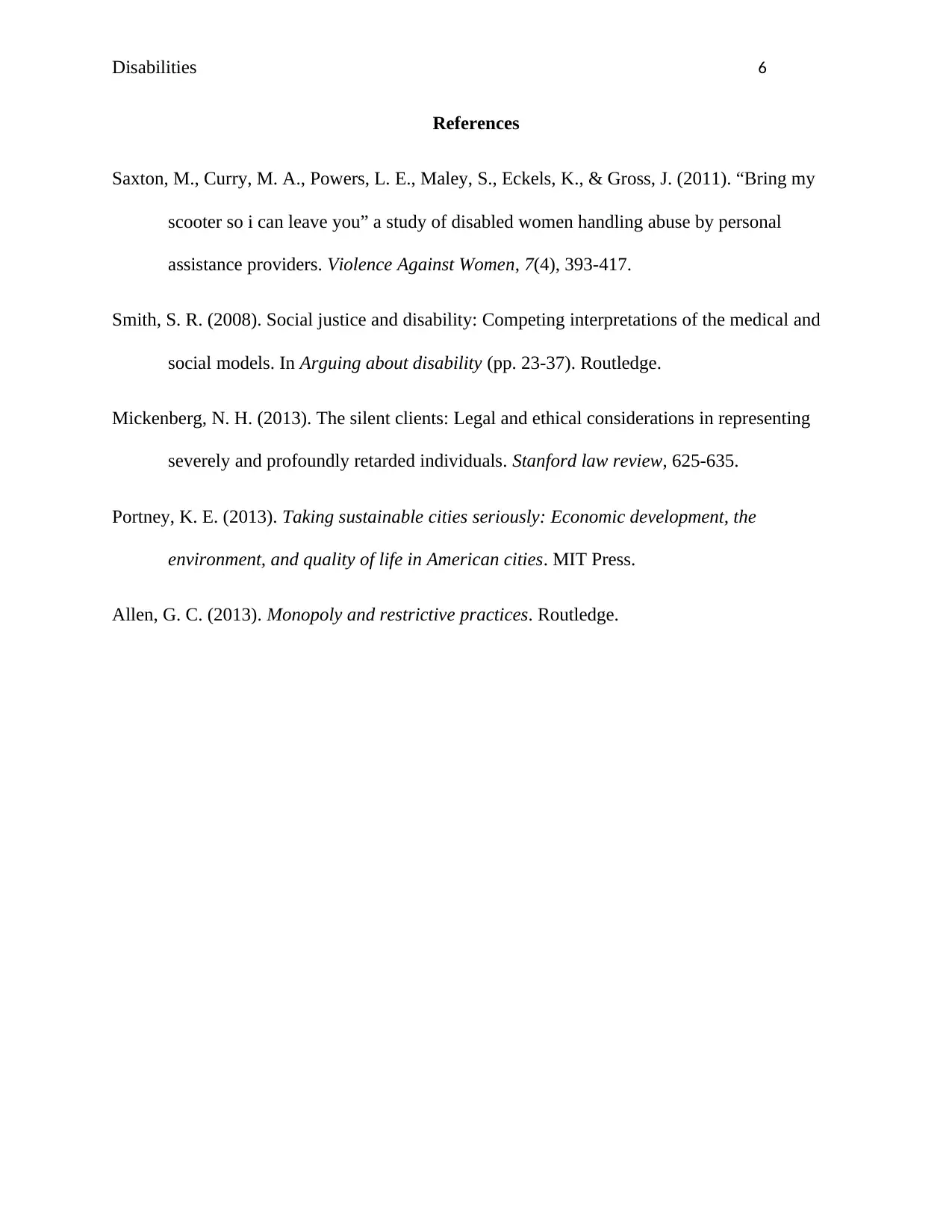
Disabilities 6
References
Saxton, M., Curry, M. A., Powers, L. E., Maley, S., Eckels, K., & Gross, J. (2011). “Bring my
scooter so i can leave you” a study of disabled women handling abuse by personal
assistance providers. Violence Against Women, 7(4), 393-417.
Smith, S. R. (2008). Social justice and disability: Competing interpretations of the medical and
social models. In Arguing about disability (pp. 23-37). Routledge.
Mickenberg, N. H. (2013). The silent clients: Legal and ethical considerations in representing
severely and profoundly retarded individuals. Stanford law review, 625-635.
Portney, K. E. (2013). Taking sustainable cities seriously: Economic development, the
environment, and quality of life in American cities. MIT Press.
Allen, G. C. (2013). Monopoly and restrictive practices. Routledge.
References
Saxton, M., Curry, M. A., Powers, L. E., Maley, S., Eckels, K., & Gross, J. (2011). “Bring my
scooter so i can leave you” a study of disabled women handling abuse by personal
assistance providers. Violence Against Women, 7(4), 393-417.
Smith, S. R. (2008). Social justice and disability: Competing interpretations of the medical and
social models. In Arguing about disability (pp. 23-37). Routledge.
Mickenberg, N. H. (2013). The silent clients: Legal and ethical considerations in representing
severely and profoundly retarded individuals. Stanford law review, 625-635.
Portney, K. E. (2013). Taking sustainable cities seriously: Economic development, the
environment, and quality of life in American cities. MIT Press.
Allen, G. C. (2013). Monopoly and restrictive practices. Routledge.
⊘ This is a preview!⊘
Do you want full access?
Subscribe today to unlock all pages.

Trusted by 1+ million students worldwide
1 out of 6
Related Documents
Your All-in-One AI-Powered Toolkit for Academic Success.
+13062052269
info@desklib.com
Available 24*7 on WhatsApp / Email
![[object Object]](/_next/static/media/star-bottom.7253800d.svg)
Unlock your academic potential
Copyright © 2020–2025 A2Z Services. All Rights Reserved. Developed and managed by ZUCOL.



